http://blog.kissmetrics.com/shocking-social-media-facts/?utm_medium=email&utm_campaign=blog_newsletter&utm_source=pardot&utm_content=blog_post_7_28_14&utm_term=null
Social media is fraught with legend, hysteria, and mass confusion. Because of its intensely personal nature, we tend to approach social media with a lot of strong feelings about its effectiveness, lack thereof, best practices, and how things should be done.
Since most of us use Facebook, we think we know how effective it will be, or what kind of posts garner the most attention and interaction. Since we have a Twitter account, we have a sense of knowledge about how it works, and what a business should do (or not do) on Twitter.
All that is great, but how much of our social media behavior is founded upon fact? I decided to dig into the data and do some research. What I’ve extracted below are five surprising data points that will have a profound effect on how you approach social media.
1. Email marketing has an ROI of 4,300%.
What? A statistic about email? You thought this was about social media, right?
My title is “Five Shocking Facts That Will Change Your Entire Approach to Social Media.” This statistic qualifies as shocking, and it impacts the way we approach on social media.
The basic fact is this: Email marketing has a huge ROI — way better than any social media marketing ROI can ever dream of achieving. Compare 4,300% that with the ROI of social media, which is crawling around on the floor. Is there even a comparison?
Take a look at this chart, released by Custora in 2013. They surveyed the owners of ecommerce sites to find out where these sites got their customers. Here are the top six sources:
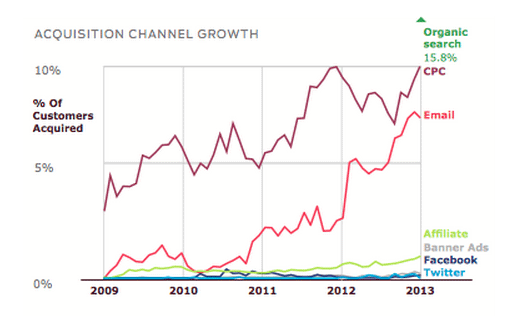
Paid and organic search have the highest customer acquisition percentages. The next biggest contender is email. Based on its ROI — higher than paid and organic search — it’s a no brainer. Email marketing is awesome.
According to the chart above, the fascinating thing about email marketing is that its acquisition rates are rising dramatically. It has quadrupled over the past four years. Email marketing’s effectiveness far outranks any social media platform, and its growth outstrips them.
Even the customer lifetime value (CLV) of social media is hardly worth a second glance. Again, email marketing crushes social media by a huge margin:
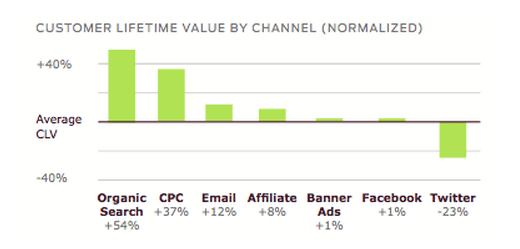
Simply put, email marketing is way more effective than social media marketing. It has greater effectiveness, better ROI, and higher CLV.
Learn this lesson: Spend more time and money on email marketing than on social media marketing.
2. YouTube has the highest engagement and lowest bounce rate.
Whenever we think of “social media,” we automatically think of Facebook, Twitter, and Google+.
What about YouTube? Check out these engagement stats!
- Average time on site: 227 seconds
- Average pages per visit: 2.99
- Average bounce rate: 43.19%
How does this stack up against the rest of the social media landscape? Decide for yourself:
The Shareaholic analysis is based on post-click behavior, which refers to clicking on a link that a friend shares socially. As the Shareaholic analysis stated, “YouTube is the undisputed champion. YT drives the most engaged traffic.”
YouTube deserves more of your social media time and effort. You can’t afford notto put more work into creating and adding videos. The more YouTube content, the more you’ll engage your potential customers.
Learn this lesson: If you want engaged traffic, spend time optimizing YouTube.
3. Facebook drives more referrals than any other social platform.
Want to know which social media site sends you the most amount of traffic? It’s Facebook — by far.
Shareaholic analyzed metrics taken over four months, measuring the effectiveness of social media platforms. There was no contest. Facebook crushed the competition, asserting itself as the most powerful social media referral engine on the planet.
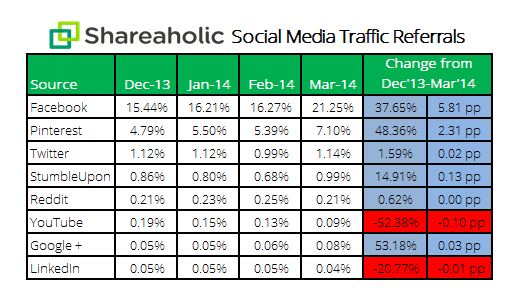
Companies gripe and complain over the way that Pages have been squashed in the Facebook algorithm. I get that. Facebook wants more ad revenue.
But even though page interaction is shrinking, there’s nothing shrinking about the number of referrals that Facebook continues to drive. Simply stated, Facebook still drives more traffic than any other social media site, soaring way above its nearest referral competition, Pinterest.
The reason why I’ve included this in my list of facts is because many marketers have become disillusioned with Facebook.
Nowadays, when I endeavor to check my Facebook statistics, I do so with the window open, birds singing, a pint of ice cream at my desk, and party jams playing on my jambox….Checking Facebook statistics has been bad news for a lot of us lately as we wrestle with declining numbers and shrinking reach.
While Kevan is staving off Facebook depression with ice cream parties and fresh air, Eat24 just decided to end the relationship with a “How dare you!”

The super long breakup letter that went into overtime with a P.P.P.S.S.S. was full of foodie talk and hurt feelings. But they were gone from Facebook for good.
If you have a fan base below 10,000 (that’s most of us), and only 28 interactions per post, please don’t be discouraged, don’t binge eat, and don’t write a breakup letter. You’re right where you ought to be, as ranked by Social Baker’s average interaction chart.
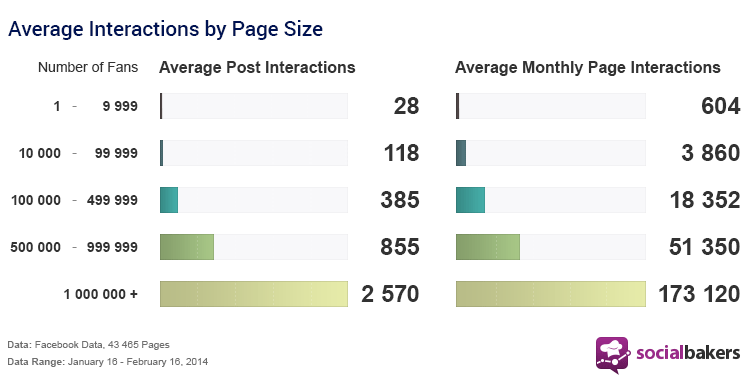
And if you’re in an unsexy industry like finance or telecom, you can expect your average post interaction to be lower, than say, an alcohol or fashion site.
In spite of the apparent downward spiral of Facebook metrics, I suggest not giving up on Facebook. Though it is fickle, and though your page isn’t featured at the top of everyone’s news feed, and though you may have to turn up your party music while you check your stats, Facebook is still giving you referrals.
As Kevan’s brilliant article concluded — “A counterintuitive way to combat Facebook reach: Stop caring about it.”
Learn this lesson: Stick it out with Facebook.
4. Pinterest pins are worth 78 cents each.
First off, a Pinterest disclaimer (or two), and then a Pinterest happy dance.
The first disclaimer is this — Pinterest has high bounce rate (53%) and low engagement. Disclaimer number two: Pinterest doesn’t work for everyone. If you are into food, crafts, photography, weddings, design, fitness, humor, travel, fashion, and inspirational quotes, then Pinterest is killer. It holds promise for some, but not for all.
The happy dance is this — Pinterest is the second biggest social media referral platform. Though it trails Facebook distantly, it still beats out Twitter, YouTube, Google+, and LinkedIn by a sizeable margin.
Now, let’s talk about ROI. Pinterest, as it turns out, does have one. But it’s a delayed reaction. When a pinner curates his or her pinboard, it takes a while for there to be social buildup, let alone revenue. Unlike Twitter, which has a short half-life, Pinterest visits increase as time goes on. It’s like wine. The older, the better.
As it turns out, the revenue doesn’t start happening until more than two months after pinning. Pinners spend more time exploring other people’s pinboards then they do searching for stuff offsite to pin. The average Pinterest pin gets 10 repins, but it takes time for those pinners to start repinning pins. This leads to a corresponding delay in revenue.
Pinterest is money, but it’s slow money. It’s like investing in a CD or a bond. The egg just takes a little while to hatch.
Learn this lesson: Use Pinterest. And be patient.
5. 65% of Twitter users expect a response in under two hours.
Customers use Twitter like a company hotline. If you don’t respond within minutes, you’re toast. Here are the lofty chronological expectations of Twitter users, in all their statistical glory:
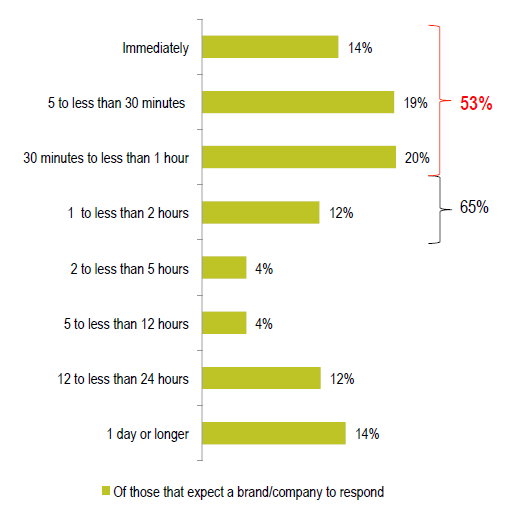
The Lithium study that produced this statistic had the headline, “Consumers Will Punish Brands that Fail to Respond on Twitter Quickly.” The flip side, “consumers will reward brands that harness Twitter’s power to meet their rising expectations.”
What kind of punishment are we talking about?
- “38% feel more negative about the brand.” As a result, they may no longer purchase from the company.
- “60% will take unpleasant actions to express their dissatisfaction…publicly shaming the brand on social media” In other words, they may spread their grief further on Twitter. It’s easy to tweet off a 140-character-or-less gripe about the company. “74 percent of customers who take to social media to shame brands believe it leads to better service.”
What’s in it for brands who are on the ball, and who respond to Tweets instantaneously?
- 34 percent are likely to buy more from that company;
- 43 percent are likely to encourage friends and family to buy their products;
- 38 percent are more receptive to their advertisements;
- 42 percent are willing to praise or recommend the brand through social media.
There’s a lot to gain by a quick response, and a lot to lose if you don’t. So if you get that Twitter notification on lunch break, don’t wait. Step on it, respond right away, and please your customers’ socks off.
Learn this lesson: If you’re going to use Twitter, stay on top of it.
Conclusion
Here are the five lessons we need to learn
- For right now, spend more time and money on email marketing than on social media marketing.
- If you want engaged traffic, spend time optimizing YouTube.
- Stick with Facebook.
- Use Pinterest. And be patient.
- If you’re going to use Twitter, stay on top of it.
Facts are indisputable, and the action points are obvious. Let’s not get lost in the romance and novelty of social media. Let’s stay clear headed, smart, and engaged. There’s power in social media, and we need to handle it in the right way.
What are some of the most compelling social media statistics that you’ve heard?
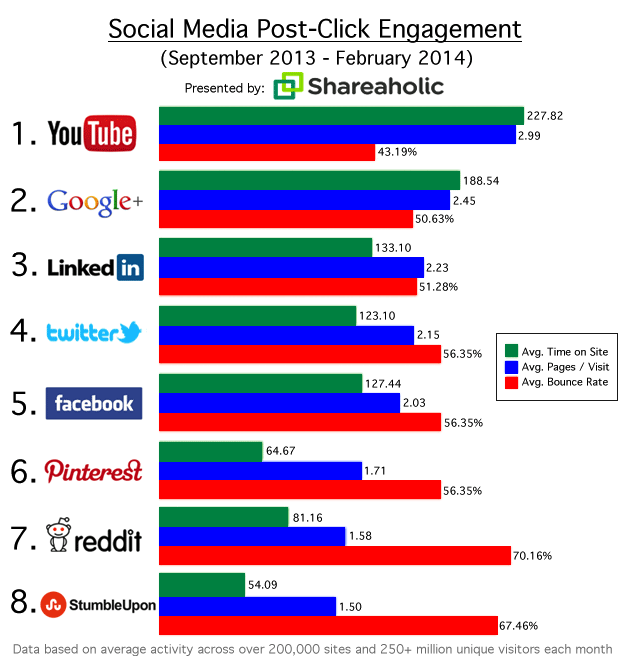
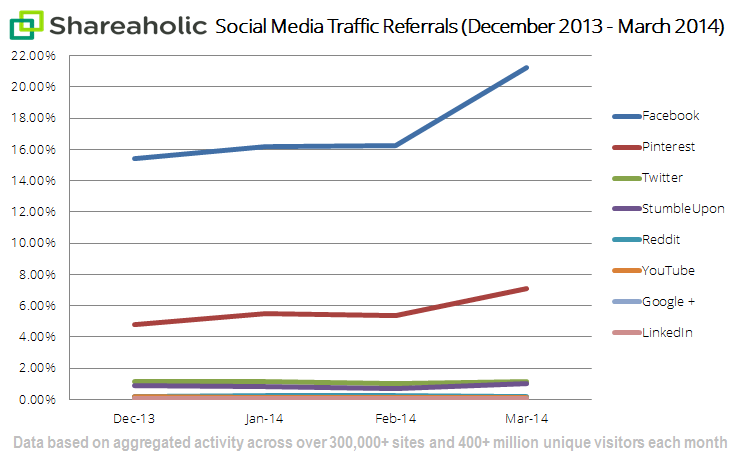
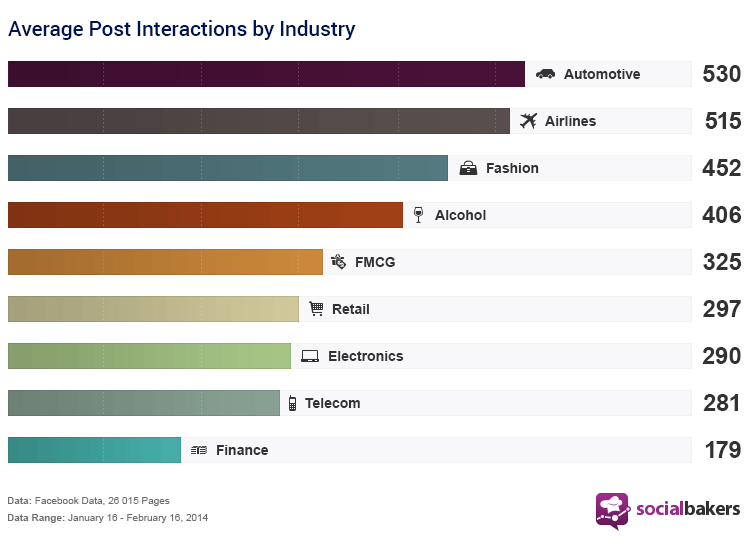


No comments:
Post a Comment